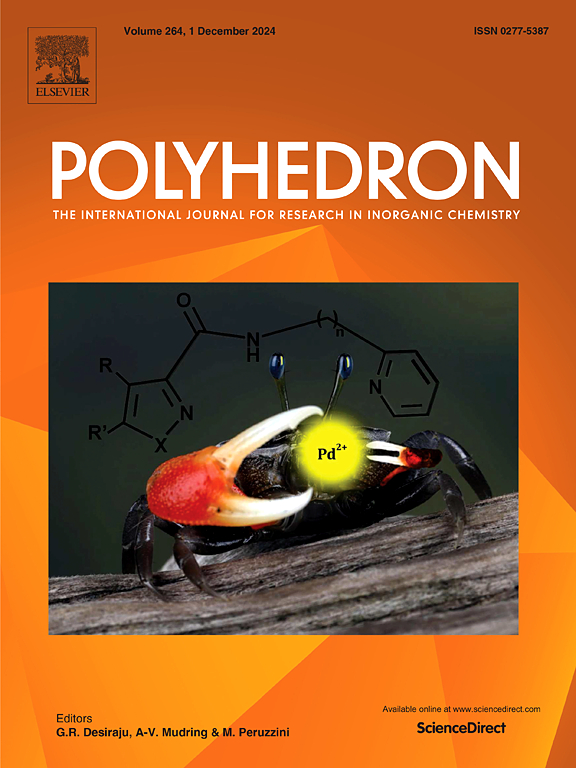利用DFT、SCAPS-1D和机器学习技术综合分析太阳能电池用Sr3PCl3吸收剂
IF 2.6
3区 化学
Q2 CHEMISTRY, INORGANIC & NUCLEAR
引用次数: 0
摘要
本研究提出了一种结合密度泛函理论(DFT)、SCAPS-1D模拟和机器学习的综合计算方法,以设计和优化无铅Sr3PCl3钙钛矿基太阳能电池。尽管钙钛矿太阳能电池表现出优异的光电性能。然而,与铅基材料有关的环境和健康危害存在重大限制。为了解决这个问题,Sr3PCl3作为一种潜在的吸收材料进行了研究。DFT计算表明,Sr3PCl3具有1.641 eV的直接带隙,高吸收系数和优异的稳定性,是光伏应用的理想候选者。使用SCAPS-1D分析器件性能,检查各种电子传输层(etl),包括WS2, CdS, SnS2和ZnS。通过优化吸收层厚度和缺陷密度来提高效率。在测试配置中,采用SnS2作为ETL的结构获得了最高的功率转换效率(PCE),达到18.58%。使用WS2、CdS和ZnS的其他配置的pce分别为17.70%、18.35%和14.15%。为了进一步加速设备优化,机器学习模型(特别是Ridge回归和catboost)在2187个SCAPS-1D仿真结果上进行了训练。这些模型基于吸收剂厚度、缺陷密度和ETL特性等关键参数准确地预测了太阳能电池的性能。为了提高可解释性,使用热图和SHAP (SHapley Additive explanation)分析等技术来检查关键参数对设备效率的影响。这个综合的框架,集成了第一性原理计算、数值模拟和机器学习,为开发稳定、高效、无铅的钙钛矿太阳能电池提供了有价值的见解。这一发现强调了Sr3PCl3作为一种环境友好型吸收材料的潜力,推进了其在下一代光电应用中的前景。本文章由计算机程序翻译,如有差异,请以英文原文为准。

Comprehensive analysis of Sr3PCl3 absorber for solar cells using DFT, SCAPS-1D, and machine learning techniques
This study presents an integrated computational approach combining Density Functional Theory (DFT), SCAPS-1D simulations, and machine learning to design and optimize lead-free Sr3PCl3 perovskite-based solar cells. Although perovskite solar cells exhibit outstanding optoelectronic properties. However, the environmental and health hazards associated with lead-based materials present a major limitation. To address this, Sr3PCl3 is investigated as a potential absorber material. DFT calculations reveal that Sr3PCl3 possesses a direct bandgap of 1.641 eV, high absorption coefficients, and excellent stability, making it a promising candidate for photovoltaic applications. Device performance was analyzed using SCAPS-1D, examining various electron transport layers (ETLs), including WS2, CdS, SnS2, and ZnS. Optimization of absorber thickness and defect density was performed to enhance efficiency. Among the tested configurations, the structure employing SnS2 as the ETL achieved the highest power conversion efficiency (PCE) of 18.58 %. Other configurations using WS2, CdS, and ZnS exhibited PCEs of 17.70 %, 18.35 %, and 14.15 %, respectively. To further accelerate device optimization, machine learning models—specifically Ridge regression and CatBoost—were trained on 2187 SCAPS-1D simulation results. These models accurately predicted solar cell performance based on key parameters such as absorber thickness, defect density, and ETL characteristics. To enhance interpretability, techniques such as heatmaps and SHAP (SHapley Additive exPlanations) analysis were utilized to examine the influence of key parameters on device efficiency. This comprehensive framework, integrating first-principles calculations, numerical simulations, and machine learning, provides valuable insights into the development of stable, high-efficiency, lead-free perovskite solar cells. The findings underscore the potential of Sr3PCl3 as an environmentally friendly absorber material, advancing its prospects for next-generation optoelectronic applications.
求助全文
通过发布文献求助,成功后即可免费获取论文全文。
去求助
来源期刊

Polyhedron
化学-晶体学
CiteScore
4.90
自引率
7.70%
发文量
515
审稿时长
2 months
期刊介绍:
Polyhedron publishes original, fundamental, experimental and theoretical work of the highest quality in all the major areas of inorganic chemistry. This includes synthetic chemistry, coordination chemistry, organometallic chemistry, bioinorganic chemistry, and solid-state and materials chemistry.
Papers should be significant pieces of work, and all new compounds must be appropriately characterized. The inclusion of single-crystal X-ray structural data is strongly encouraged, but papers reporting only the X-ray structure determination of a single compound will usually not be considered. Papers on solid-state or materials chemistry will be expected to have a significant molecular chemistry component (such as the synthesis and characterization of the molecular precursors and/or a systematic study of the use of different precursors or reaction conditions) or demonstrate a cutting-edge application (for example inorganic materials for energy applications). Papers dealing only with stability constants are not considered.
 求助内容:
求助内容: 应助结果提醒方式:
应助结果提醒方式:


